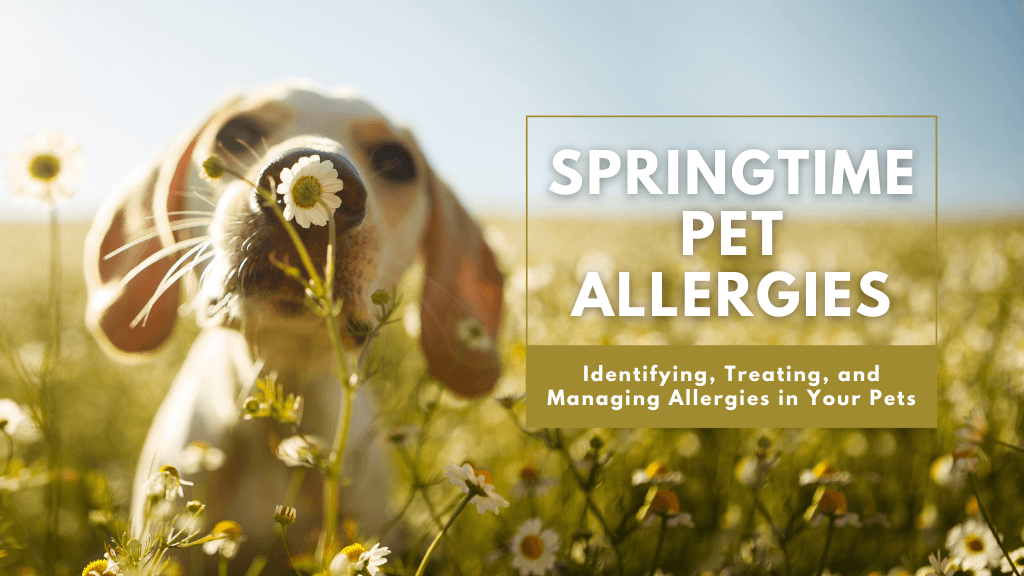Managing Springtime Allergies in Pets
)
As spring brings warmer weather and blooming flora, it also ushers in a range of allergens that can cause discomfort for our pets. Much like humans, pets can suffer from seasonal allergies triggered by pollen, grass seeds, dust, and spores that fill the air. These allergies often result in skin irritation, excessive scratching, and even more severe health concerns. This guide will help you identify, manage, and treat pet allergies to ensure your furry friends remain happy and healthy during the spring season.
Recognising Signs of Allergies in Pets
Unlike humans, who often experience hay fever symptoms like runny noses or itchy eyes, pets usually show signs of allergies through skin issues. Recognising these symptoms early is crucial for managing your pet’s health effectively. Here are five key indicators to watch for:
Increased Scratching and Licking
One of the earliest signs of an allergic reaction is constant itching. If your pet is scratching or licking their skin and coat more than usual, it could be due to allergens irritating their skin. Excessive licking or biting can worsen the condition, leading to open sores.Hair Loss
Unrelieved itching and biting at the skin can cause hair loss, especially in areas affected by allergens like grass seeds. Dogs and cats with untreated allergies may lose patches of fur, as constant grooming exacerbates the issue.Red Sores and Irritated Skin
When your pet scratches too much, it can result in red, raw areas of skin or even open sores. These irritated spots can become infected if left untreated, causing further discomfort and requiring medical attention.Ear Infections
Pets are susceptible to ear infections when allergens like pollen or dust enter the ear canal. Persistent head shaking or ear scratching can indicate an ear infection caused by allergies. Early treatment is essential to prevent serious complications.Respiratory Issues
Although less common than skin-related symptoms, some pets may experience respiratory problems, such as sneezing, coughing, or watery eyes, due to airborne allergens. These symptoms can resemble those seen in humans with allergies and should not be ignored.
Steps to Manage Allergies in Your Pet
There are several proactive steps you can take to help your pet manage their allergies. Implementing these strategies can minimise their symptoms and enhance their comfort throughout allergy season.
Regular Bathing and Grooming
Frequent baths with hypoallergenic pet shampoos can wash away allergens trapped in your pet’s coat, helping to soothe irritated skin. Regular brushing also helps remove pollen, dust, and spores, preventing them from accumulating in your pet’s fur.
Care for Your Pet’s Paws
Allergens often stick to your pet’s paws, especially after outdoor walks. Rinsing their paws after outings can reduce irritation, while trimming long fur around their feet can limit the amount of allergens they collect.
Flea Control
Fleas are a common cause of allergic reactions in pets. Regular use of flea prevention treatments can help protect your pet from bites, which can worsen allergic symptoms. Consult your vet for the best flea prevention products for your pet.
Minimise Indoor Allergens
Keeping your home clean can significantly reduce your pet’s exposure to allergens. Vacuum regularly, mop hard floors, and wash your pet’s bedding to keep pollen and dust to a minimum. You might also consider using a HEPA air filter to improve air quality indoors.
Consult Your Vet
If you suspect your pet is suffering from allergies, scheduling a visit to the vet is essential. Our team at Taringa Vet can help diagnose your pet’s allergies and develop a personalised treatment plan. This could involve allergy testing, where specific triggers are identified and addressed. Immunotherapy may also be suggested to desensitise your pet to certain allergens. Medications and supplements may be prescribed to control itching and inflammation.
Dietary Adjustments
Although environmental allergies are more common, food allergies can also play a role in your pet’s allergic response. If food allergies are suspected, your vet might recommend a hypoallergenic or elimination diet to rule out specific triggers. It’s important not to make dietary changes without professional guidance to avoid exacerbating the problem.
Springtime can be a challenging season for pets with allergies, but with the right care and preventative measures, you can help your pet thrive. By staying alert to the signs of allergies, keeping their environment clean, and consulting your vet for proper treatments, you can ensure your furry friend enjoys the season to its fullest.
At Taringa Vet, we are here to support you with expert advice and tailored care to manage your pet’s allergies effectively. Together, we can help your pet experience spring in comfort and health.
| Tags:Proactive Pet CareClient Information |

